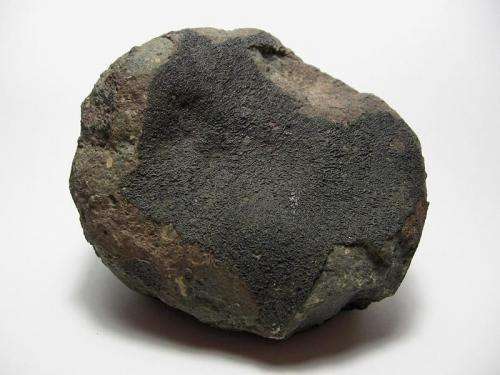October 14, 2013 report
Reexamination of Allende meteorite reveals isotopic evidence of supernova

(Phys.org) —A combined team of researchers from Lawrence Livermore National Laboratory and Arizona State University has found isotopic evidence of a supernova inside of a meteorite that fell to Earth in 1969. In their paper published in Proceedings of the National Academy of Science, the team describes how isotopes found in the Allende meteorite differ from those found on Earth or on the moon, suggesting they came directly from a supernova rather than from a debris field that followed.
Scientists agree that our solar system formed approximately four and a half billion years ago—how exactly it happened, however, is still a matter of debate. Most agree that it was likely the result of one or more stars exploding, because the heavy matter that makes up our planet is only known to form in stars, or when they explode as a supernova. Research has even led to a theory describing how three types of isotopes come about: p-, s- and r-processes, from which all matter heavier than nickel is made. In this new effort, the researchers found isotopes inside the Allende meteorite that conform to the r-process; this they contend, suggests that the isotopic material very likely came about directly when a supernova exploded. The rest of the meteorite (the outer shell) likely came about as debris from the explosion followed sometime later. This discovery has added new details to theories about the way our solar system came to exist.
One theory suggests that a single supernova explosion led to the creation of our sun and later the planets as debris from the explosions entered the system. Another suggests that our sun could have been created by more than one supernova, all of which would have likely contributed, via debris, to the matter that coalesced into planets. The material in the Allende meteorite helps refine such theories by narrowing the window of its injection into our system to a relatively small time frame—perhaps as small as 20 to 50 thousand years.
Clumps inside the meteorite, known as inclusions, are believed to represent some of the oldest material in the solar system and offer the best evidence possible of what was happening as our solar system was being created.
More information: Evidence for supernova injection into the solar nebula and the decoupling of r-process nucleosynthesis, PNAS, Published online before print October 7, 2013, DOI: 10.1073/pnas.1307759110
Abstract
The isotopic composition of our Solar System reflects the blending of materials derived from numerous past nucleosynthetic events, each characterized by a distinct isotopic signature. We show that the isotopic compositions of elements spanning a large mass range in the earliest formed solids in our Solar System, calcium–aluminum-rich inclusions (CAIs), are uniform, and yet distinct from the average Solar System composition. Relative to younger objects in the Solar System, CAIs contain positive r-process anomalies in isotopes A < 140 and negative r-process anomalies in isotopes A > 140. This fundamental difference in the isotopic character of CAIs around mass 140 necessitates (i) the existence of multiple sources for r-process nucleosynthesis and (ii) the injection of supernova material into a reservoir untapped by CAIs. A scenario of late supernova injection into the protoplanetary disk is consistent with formation of our Solar System in an active star-forming region of the galaxy.
Journal information: Proceedings of the National Academy of Sciences
© 2013 Phys.org


















